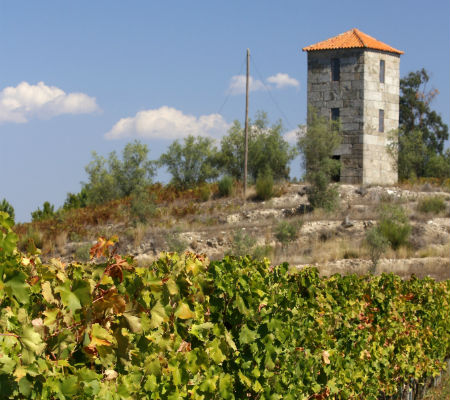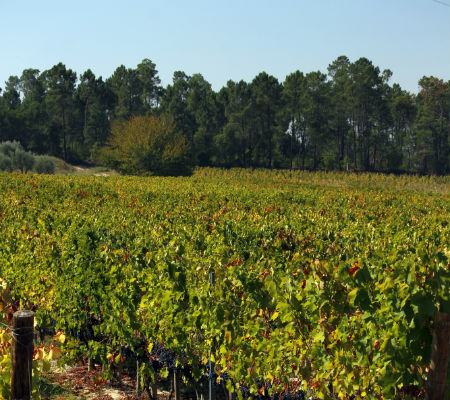Text João Barbosa | Translation Bruno Ferreira
The Dão is rising. The region has awakened and started moving. As you would expect, there will be mistakes, nothing is perfect but just the fact of reacting is already worthy an applause. It is awaking and scoring points, walking the path to retrieve the status it once had. Merit has to be given to the Comissão Vitivinícola Regional, but this was only possible because there were producers determined to do well and get financial return.
Carlos Lucas is one of the men that led the rising with his passage in Dão Sul, nowadays Global Wines, a company that is now present in Alentejo, Bairrada, Douro, Lisboa, Vinho Verde and Brazil (Vale do São Francisco) as well.
Dão Sul appeared in 1990. The brands Quinta de Cabriz and Quinta dos Grilos introduced themselves with inviting prices and with easy consumer pleasing features. The success led them to expand beyond their cradle.
The wines from Quinta de Ribeiro Santo, located in Carregado do Sal, confirmed Carlos Lucas’ touch rightness. The Dão would not be the same today and would be perhaps very different without the work of this winemaker.
Quinta da Alameda is a partnership between Carlos Lucas and the businessman Luís Abrantes with activity in the furniture industry (Movecho). Amândio Cruz is in charge of the viticulture. It’s located in Santar, Nelas municipality. The area is small for the European standards but above the region’s average and it’s comprised by 50 hectares 15 of which are vineyard.

The vineyard – Photo Provided by Quinta da Alameda | All Rights Reserved

The vineyard – Photo Provided by Quinta da Alameda | All Rights Reserved
For those who like numbers, in 2009 from the total of 305.266 agricultural enterprises, 283.071 had less than 20 hectares – a number that has been getting smaller since 1979 (2,6 times inferior). The utilized agricultural area has also been decreasing, although at a smaller pace (1,4 times inferior). The Center region, where lies the Dão, is one of the regions with smaller size.
Let’s leave the numbers and move on to what matters the most. The two partners kept a portion of the old vine, where lie several grape varieties blended as tradition demands, and they transformed another portion where they planted Alfrocheiro, Baga, Jaen, Tinta Roriz, Tinto Cão and Touriga Nacional.
It’s located in an area where the altitude goes from 400 to 700 meters, close to Serra da Estrela and the Dão river. Translation to one word: freshness. The reason behind the choice of these new grape varieties was the production of sparkling wines.
The valorization of the old vines by observing the quality of the produced wines created a fashion. Those who have vines with 30 years say they are old… to me they are not. In Quinta da Alameda, the age of these plants is over 80 years.
Carlos Lucas confessed not being a fan of the Jaen grape variety. However, in Quinta da Alameda he changed his opinion, in 2012. The following year he vinified it separately. The result debuted recently and I’m going to talk about it a little further ahead.
The Dão region has a special classification category that can be compared to the Port Wine’s Vintage classification. Carlos Lucas says he doesn’t know if “Dão Nobre” was ever attributed and forseens it to be hard to happen.
The Quinta da Alameda red Reserva Especial 2012 was submitted to exam and did not earn the distinction, as the reader must have already understood from the previous paragraph. It was categorized as Reserva Especial, which in some way is the same. If the top is inaccessible, the level immediately below occupies its place.

Carlos Lucas – Photo Provided by Quinta da Alameda | All Rights Reserved

Quinta da Alameda red Reserva Especial 2012 – Photo Provided by Quinta da Alameda | All Rights Reserved
The received classification is fair! It’s a great wine and has what it should be expected from the Dão. The region lives in these bottles, where the memories of the old vines and the recognized categories have been kept since ever.
Quinta da Alameda red Reserva Especial 2012 was made with Alfrocheiro, Tinta Roriz, Tinta Cão and Touriga Nacional grapes… a pinch of Baga, outlawed grape variety despite its former presence around there in the past. The wine aged one year in French oak and another 12 months in bottle. It’s a wine with a great freshness, softness and elegance. A freshness that covers the 14 degrees of alcohol – you won’t even notice it.
The Quinta da Alameda red Jaen 2013 expresses well the grape variety. It’s an educational wine on two levels: What is the Jaen grape variety? and What is a Dão wine? – despite the tradition being blend wines. The aging in French oak casks lasted a year. It’s an equally red with freshness that provides good pleasure with elegance for which the region was/is known.
As you should expect, I don’t boss a thing in the Dão region, as I don’t in none of the others. Nonetheless, I think that by not validating wines as “Dão Nobre” the tasting panel is not benefiting anyone. It would be a good help for the older consumers to find themselves and for the newcomers to venture in the wonders that, in fact, exist in the region.
Other regions might get first a new designation for a higher classification, benefiting from the primacy. Each one knows of themselves and their businesses. This is my opinion and it’s worth whatever the reader wants it to be worth.
Let us remember that in Bordeaux, Burgundy or Champagne there are “never” bad years… they are either excellent or classic. The top classifications are used and France is what it is.




Leave a Reply